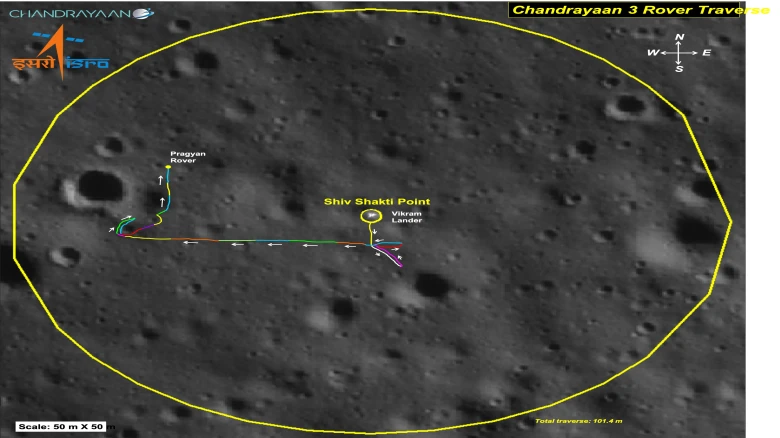Regional

Pragyan rover, part of the Chandrayaan-3 lunar mission, has successfully traversed more than 100 meters on the...
Digital Desk: In an exciting update from the Indian Space Research Organisation (ISRO), it has been revealed that the Pragyan rover, part of the Chandrayaan-3 lunar mission, has successfully traversed more than 100 meters on the Moon's surface. This significant achievement was announced today, marking another milestone in India's ambitious lunar exploration journey.
The Pragyan rover continues to explore the enigmatic lunar south pole region after rolling out from the Vikram lander. Its journey has been an eventful one, as it embarked on its initial path southwards and later changed its direction to move southeast. During this journey, Pragyan encountered a substantial lunar crater with a diameter of four meters. Fortunately, the rover's adept navigation system allowed it to maneuver safely out of the crater after a series of precise commands. Following this brief detour, Pragyan changed its course once again, this time moving west before eventually heading northwards.
Chandrayaan-3 made headlines when it softly touched down on the Moon's south pole on August 23, 2023, making India the first nation to achieve such a feat. Just four hours after the historic touchdown, the Pragyan rover began its exploration, and the next day, both the lander and rover payloads were activated. In just a week of operations on the lunar surface, Chandrayaan-3's payloads have made groundbreaking discoveries that have piqued the interest of the global scientific community.
As of today, Chandrayaan-3 has been operational on the Moon for nine days. The mission's duration for both the Vikram lander and Pragyan rover is set at 14 days, which means that approximately five days remain in their mission life. During this time, the mission has already achieved significant milestones, including confirming the presence of sulphur on the lunar surface, creating the first-ever temperature-depth profile of the Moon's south pole, discovering the sparse nature of the plasma environment above the lunar south pole region, and even detecting a potential lunar quake, among other remarkable feats.
Following the completion of their mission, Vikram and Pragyan will be decommissioned but will remain on the Moon. There is a possibility that these resilient lunar explorers may continue to function beyond their designated mission duration, adding to the treasure trove of lunar data.
In another significant development, ISRO marked the successful launch of Aditya-L1, India's first space-based observatory designed to study the Sun. The launch took place on September 2, 2023, with the PSLV-C57 rocket efficiently placing Aditya-L1 into low-Earth orbit. This state-of-the-art observatory will embark on its journey to its final destination, a halo orbit around Lagrange point 1 (L1), and is expected to arrive there in January 2024, promising to provide valuable insights into our Sun and its behavior.
The Chandrayaan-3 mission and the launch of Aditya-L1 underscore India's growing prowess in space exploration as it continues to push the boundaries of scientific discovery and technological innovation on the lunar surface and beyond.
Leave A Comment